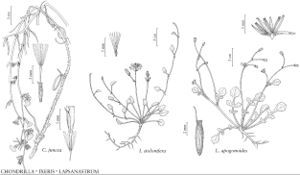Lapsanastrum
Taxon 44: 19. 1995.
| Taxon | Illustrator ⠉ | |
|---|---|---|
 | Chondrilla juncea Ixeris stolonifera Lapsanastrum apogonoides | Bee F. Gunn Bee F. Gunn Bee F. Gunn |
Annuals [biennials], 10–20 cm; taprooted [occasionally stoloniferous]. Stems 1–20+, prostrate, simple or sparingly branched distally, slender, glabrous. Leaves basal and cauline; petiolate or sessile; basal blades oblanceolate, lyrate-pinnately lobed (lateral lobes relatively wide, terminals relatively large); cauline relatively few, reduced. Heads in loose, corymbiform arrays or borne singly. Peduncles not inflated, minutely bracteate or naked. Calyculi of 2–4 scalelike bractlets (to 1 mm, equal), glabrous. Involucres cylindro-campanulate, 4–8 mm diam. Phyllaries 5 [–7] in 1 series, broadly to narrowly lanceolate, equal, margins not scarious, apices acute to acuminate, faces glabrous. Receptacles ± flat, smooth, glabrous, epaleate. Florets 5–8; corollas yellow (glabrous [pubescent]). Cypselae golden brown, oblong, adaxially flattened, (often 2-winged with 1–2 apical hooklike projections [hooks 0 in some species]), not beaked, ribs 10–13, ciliate; pappi 0. x = 8.
Distribution
Introduced; Asia
Discussion
Species 4 (1 in the flora).
Members of Lapsanastrum were formerly included in Lapsana. Cladistic analysis by J. H. Pak and K. Bremer (1995) indicated that they are distinct from Lapsana communis and are more closely related to Youngia, supporting their recognition as a distinct genus.
Selected References
Lower Taxa
"fine" is not a number.